| Lot |
Photo |
Description |
Realized |
Lot 863 |
 |
Outstanding Vintage Original Russian Seismometer, Case Made of Bakelite. Rare, handsome, vintage original Russian seismometer with a beautiful glass and bakelite case. Bakelite instruments are highly prized and this one boasts great visual appeal. Seismometer looks complete but not working at present. Difficult to translate some of the cyrillic writing but it appears it was manufactured in Latvia. Again a striking piece for any office and a must for collectors of antique bakelite. We were unable to find any record of a Russian example, but a US version is wooden case is available for view on Shutterstock. Estimate Value $500 - UP
View details and enlarged photo
| Unsold |
Lot 864 |
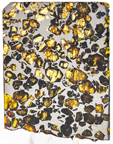 |
Large 201 Gram Esquel, The Most Beautiful Pallasite. Discovered in 1951 by a farmer in Chubut, Argentina, the single 680 Kg meteorite known as Esquel has been in great demand as the most beautiful of the rare type of meteorites known as pallasites. There are three major types of meteorites: iron, stony and stony-iron. Pallasites are stony-iron meteorites that originate from the core-mantle boundary of large planetary size asteroids that were destroyed early in the formation of the solar system. This rare type of meteorite consists of iron-nickel from the core of the asteroid, as well as olivine crystals known as peridot from the mantle. Peridot crystals (the gem state of olivine crystals) are the only known gem stones from space found in meteorites. Esquel is considered to be the most beautiful of all pallasites and in now rarely available as the single discovered meteorite has been completely sectioned with only the main mass end piece remaining. This very large 5.5 x4 x 1/8 inch section of Esquel has been polished on both sides to get the maximum reflection of the iron-nickel matrix, as well as displaying many beautiful translucent colors-- lightly shocked green to orange olivine crystals. It weighs a hefty 201 grams and is presented in an 8x12 inch Riker mount. Purchased from Robert Hague (owner of the Esquel Pallasite) over 15 years ago. Estimate Value $5,500 - UP
View details and enlarged photo
| Unsold |
Lot 865 |
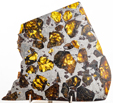 |
Gem Quality Meteorite Fukang Pallasite. Pallasites are by far the rarest and most beautiful of the major types of meteorites and are thought to have originated at the mantle-core boundary of very large differentiated asteroids that were destroyed during the early formation of the solar system over 5 billion years ago. Pallasites are a combination of iron-nickel and olivine crystals. Gemstones of olivine are known as Peridot, literally making Pallasites gemstones from space. Fukang is considered to be one of the most beautiful of Pallasites because it contains the largest crystals of olivine mixed in its iron-nickel matrix. Only one large 1003 Kg meteorite was recovered near Fukang, China in 2000. This large museum quality slice is 3.5 x 3.5 inches and weighs a hefty 83.3grams and is housed in a 6 x 5 inch Riker mount. The true beauty of this translucent slice can only be appreciated when held up to a light source that enables the large olivine crystals to dazzle. Premium Fukang polished sections such as this have been bringing $30-$40 per gram at meteorite auctions. Estimate Value $2,500 - UP
View details and enlarged photo
| Unsold |
Lot 866 |
 |
Lunar Meteorite End Cut Plus Flown Apollo 11 Kapton Foil. The only way to legally own a piece of the moon is to acquire a rare piece of a lunar meteorite. This lot contains a 1.042 gram 18x12 mm polished end cut of Lunar meteorite Northeast Africa 001. The end cut has the cut side polished and the back side is untouched showing the surface of the meteorite. This lunar meteorite is an anorthositic regolith breccia from the Lunar highlands that was blown off of the moon by a meteorite impact and was found in April 2002 in northern Sudan near the Libya/Egypt/ Sudan border. Only a single meteorite weighing 262 grams (just over ½ pound) was found. The polished section has a number of white and light gray mineral clasts embedded in a dark gray microcrystalline impact melt matrix. The meteorite is also historical as being the very first meteorite to be authenticated from Northeastern Africa.
Also, included in a 12x8 inch Riker mount is a one inch square gold flown Apollo 11 Kapton foil which came from the Apollo 11 Command Module, Columbia after its splash down in the Pacific ocean from its historic first lunar landing. This Kapton foil provided thermal protection for the Command Module as it passed through the earth's atmosphere on the return flight from the moon. The foil is made from gold on one side and silver on the other and has been mounted in an acrylic square for protection. This foil comes with a signed document that it was given to retired NASA engineer W.R. Whipley in Production Control in 1969. Apollo 11 was the most famous NASA mission of all time with Neil Armstrong being the first man to walk on the moon. Besides the authentification card for the Moon meteorite and signed certificate for the Kapton foil, there is a color photograph of the Command Module showing the gold Kapton foil covering its outer surface. Estimate Value $2,000 - UP
View details and enlarged photo
| Realized
$1,920 |
Lot 867 |
 |
20.5 Pound Campo del Cielo Iron Nickel Meteorite. This new Campo del Cielo iron-nickel meteorite is large at 9 x 6 ½ X 3 inches weighing 20.5 pounds and has an esthetic shape covered with medium to large sized regmaglypts on one side and many smaller regmaglypts on the other side. Regmagylpts formed when the meteor passed through Earth�s atmosphere and the troilite in the meteorite melted. First recorded by the Spanish in 1576, the huge fall of Campo del Cielo (Valley of the Sky) iron-nickel meteorites occurred thousands of years before. The best quality Campos such as this splendid specimen were recovered high in the mountains where their surface was not rusted away by ground water. The Campo field has been mostly explored and the price of large quality Campos is rising dramatically as new specimens are getting to be very difficult to locate and demand for meteorites has been steadily increasing. Estimate Value $1,500 - UP
View details and enlarged photo
| Realized
$938 |
Lot 868 |
 |
Seven Pound Stony Meteorite End Cut With a Polished Face. Most stony meteorites are small (less than 1 pound) because the larger stony meteorites usually break apart or explode before they make contact with the earth. This huge 8 x7 x 2¾ inch 7 pound stony meteorite end cut is one of the exceptions. It is designated as an unclassified NWA (North West Africa) stony meteorite and was found by nomadic Berbers in the sands of the Sahara desert of Morocco. It is an ordinary chondrite which means that it consists of round silicate grains that formed at the very beginning of the solar system 4.55 billion years ago. This stony meteorite is a medium brown in color with a 5¾ x 2¾ inch polished end cut revealing some medium and dark brown irregular shaped chondrites and flecks of iron-nickel,which makes it magnetic. Large stony meteorites are hard to come by as most of the larger meteorites found have been cut up for slices. Estimate Value $1,500 - UP
View details and enlarged photo
| Realized
$840 |
Lot 869 |
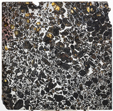 |
Large Section of Seymchan Pallasite. Two meteorites weighing 323 Kg were found in 1967 in Seymchan, a Magadan district in far eastern Russia. Originally, Seymchan was believed to be just an iron-nickel meteorite but recently olivine crystals were found in parts of some of the Seymchan meteorites which makes it a far rarer Pallasite. Pallasites are literally gemstones from outer space containing olivine crystals mixed in with the iron-nickel matrix. This large 4.5 x 4.1 inch 170.2 gram slice has more than 50% olivine crystals and silicate inclusions in its iron-nickel matrix and has been polished to reveal this interesting interior including many translucent olivine crystals. The silicate inclusions are found in a type of stony iron meteorite known as a Mesosiderite. Therefore, this Seymchan section is a mix between a Pallasite and a Mesosiderite. The olivine cryatals in Seymchan are smaller in diameter than in most Pallasites. Seymchan slices are remarkably stable. Comes in a 8x6 inch Riker Mount for presentation. Estimate Value $1,500 - UP
View details and enlarged photo
| Unsold |
Lot 870 |
 |
Opalized 120 Million Year Old Coober Pedy Fossil Belemnite. The best quality of fire opal comes from the famous Coober Pedy region of Australia. Coober Pedy is a very small town in northern South Australia. As rare as fire opals are, they are much rarer to find in a fossil. This 3.5 x 2.5 inch natural beige colored stone matrix contains a 36mm (about 1.5 inch) 120 million year old opalized belemnite that has been polished to reveal the fine fire opal colors of orange, purple and green. Belemnites are an extinct group of cephalopods that are related to squid and the chambered nautilus. The only part of the extinct belemnite that fossilizes is the torpedo shaped shell that is contained inside its body and makes it rigid for swimming. This is a rare opportunity to purchase a gemstone (Opal) contained within a 120 million year old fossil. Estimate Value $1,500 - UP
View details and enlarged photo
| Unsold |
Lot 871 |
 |
Meteorite Blade Knife Made From Muonionalusta Iron-Nickel Meteorite. This beautiful 6.75 inch long Meteorite Blade Knife has a 2.75 inch blade made from a slice of the Muonionalusta iron-nickel meteorite along with a polished four inch Eudialyte handle. Muonionalusta is an iron-nickel meteorite that fell thousands of years ago in the far north and was carried by glaciers until it was found in Norrbotten, Sweden in 1906. Eudialyte is a pink, violet or plum colored gemstone from Kola, Russia that is a rare nine member ring cyclosilicate which forms in alkaline igneous rocks. Eudialyte is used as a gemstone in jewelry but is limited due to its rarity. The four inch long meteorite blade is 1.25 inches wide with 2/3 of the blade polished to show the Widmanstatten pattern and 1/3 of the blade of polished reflective iron-nickel. This beautiful and valuable meteorite knife should appeal to both meteorite and mineral collectors and comes with a small plastic stand for display. Estimate Value $1,300 - UP
View details and enlarged photo
| Unsold |
Lot 872 |
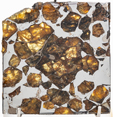 |
29.6 Gram Esquel: The Most Beautiful Pallasite. Discovered in 1951 by a farmer in Chubut, Argentina, the single 680 Kg meteorite known as Esquel has been in great demand as the most beautiful of the rare type of meteorites known as pallasites. Pallasites are a rare type of meteorite consisting of iron-nickel from the core of the asteroid as well as olivine crystals known as peridot from the mantle. Peridot crystals(the gem state of olivine crystals) are the only known gem stones from space found in meteorites. Esquel is now rarely available as the single discovered meteorite has been completely sectioned. This 29.6 gram 2 x 1 3/4 inch section of Esquel has been polished on both sides to get the maximum reflection of the iron-nickel matrix as well as displaying many beautiful translucent lightly shocked green to orange olivine crystals. Estimate Value $1,000 - UP
View details and enlarged photo
| Unsold |
Lot 873 |
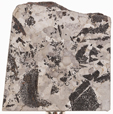 |
Rare Slice of a Silicated NWA 5549 Iron-Nickel Meteortie. All silicated Iron-Nickel meteorites are very rare and important because they match up with oxygen isotopes with the also rare primitive achondrites like Winonaite. Most stony meteorites are chondrites meaning that they have round chondrites in their make up. Achondrites lose most of their original chondrites because of metamorphism and partial melting. This sizeable 101.4 grams 2x13/4 inch partial slice of NWA 5549 found in Algeria in 2008 has been polished and etched showing many silicate inclusions in the iron-nickel fields. The silicate inclusions are chondritic in chemical composition but being recrystallized makes them an achondrite. Matching up with Winonaite means that the IAB NWA 5549 originated from the same parent body. Winonaites came from closer to the surface and NWA 5549 from deeper in the core of the yet to be discovered planetesimal body. Estimate Value $1,000 - UP
View details and enlarged photo
| Unsold |
Lot 874 |
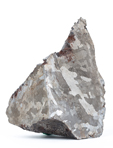 |
Meteorite Campo del Cielo Etched Half. The famous iron-nickel meteorite Campo del Cielo fell to the earth over 4,000 years ago in mountainous region of Gran Chaco, Argentina. This heavy 5 x 3 x 2.75 inch meteorite cut in half weighs 4.5 pounds and has been polished and etched on two sides to show its Widmanstatten pattern which results from two alloys of Nickel in the meteorite etching at different rates. This spectacular half meteorite has the original surface with regmaglypts and fusion crust all around except for two sides that have been beautifully etched to show the coarse octahedrite pattern of this Type 1A iron-nickel meteorite. Estimate Value $800 - UP
View details and enlarged photo
| Unsold |
Lot 875 |
 |
Chelyabinsk 39.6 Gram Meteorite from the Largest Meteorite Fall Since 1907. At 9:20 A.M. on the morning of February 15, 2013 a large 8-10 ton 50 foot long meteor exploded 10-15 miles above the ancient city of Chelyabinsk, Russia with the force of over 500,000 tons of TNT-- 10 times the force of the atomic bomb that destroyed Hiroshima in 1945. More than 1,500 people were injured from flying glass and debris from the resulting shock wave. This was the largest meteor event in the last 100 years, since a large meteor exploded over a remote area of Siberia in 1907. Because of the immense explosion and ablation through Earth's atmosphere, most of the meteor was either burned up or blasted into a fine powder. More than 95% of the recovered meteorites are extremely small, less than 3 grams in weight.
This beautiful fresh stony 45x25x15 mm complete specimen weighs 39.6 grams, which is much larger than the vast majority recovered. It has a fresh dark brown fusion crust covering more than 95% of the meteorite, with a small viewing window inside of the meteorite showing its light gray matrix mixed with a large iron rich orange chondrule and other various shaped chondrules. This stony chondrite is designated as LL5 SR4, meaning that it is of low iron even for a stony meteorite, with the total iron content about 10 percent. It is not possible to obtain a fresher meteorite and it is very valuable for study in that there has been no contamination with Earth rocks and erosion. It comes housed in an 8x6 inch Riker mount with a photo of the explosion. Estimate Value $650 - UP
View details and enlarged photo
| Unsold |
Lot 876 |
 |
Meteoric 300 Gram Libyan Desert Glass Tektite. Tektites are a mixture of earth rocks mixed with a sprinkling of meteorite material from an immense explosive event that occurred when a very large rocky meteorite vaporized before impacting the earth. The resulting mixture forms a glass-like mixture. The color is usually black but it can also be green or yellow depending on the amount of silica present. This large 4½ x2 x 2 inch 300 gram specimen of Libyan Desert Glass was found buried in the sand of the Sahara (near the border of Libya and Egypt). It is a lovely medium yellow-green color with many small regmaglypt-like impressions. Comes with a 3 inch Ryker Mount. Estimate Value $650 - UP
View details and enlarged photo
| Unsold |
Lot 877 |
 |
Sikhote-Alin Transitional Type Meteorite. This large 3 x 1¾x ¾ inch, 263.4 grams Sikhote-Alin iron nickel meteorite is an interesting transitional specimen that has some characteristics of the shrapnel type with sharp edges and flow lines plus some shallow regmaglypts that were not fully developed at impact. The large meteorite body broke up twice during its fall to earth with only the higher breakup creating the meteorites with the regmaglypts, the lower breakup creating the shrapnel type meteorites. Having fallen on Feb. 12, 1947 in Siberia, Sikhote-Alin iron-nickel meteorites are the best preserved of all known iron-nickel meteorites and in great demand. Estimate Value $600 - UP
View details and enlarged photo
| Realized
$660 |
Lot 878 |
 |
Famous Canyon Diablo Iron-Nickel Meteorite. This 514.3 gram (over 1 pound) 3 x 2½ x 1 inch Canyon Diablo iron-nickel meteorite is a palm sized specimen of one of the most sought after iron meteorites by collectors. Most currently available Canyon Diablo meteorites are just a few grams in weight. Any sizeable specimens are hard to come by as the area around Meteor Crater near Winslow, Arizona has been closed for many years. The nearly one mile in diameter crater was created over 50,000 years ago when a meteor 50 feet in diameter exploded high over the Arizona desert. This popular esthetic meteorite possesses several regmaglypts (thumbprints) plus an esthetic shape. Since no specimens are available from the source at Meteor Crater, the only way to acquire a specimen is when specimens are made available from collections. Estimate Value $600 - UP
View details and enlarged photo
| Unsold |
Lot 879 |
 |
673 Gram Gebel Kamil Ataxite Meteorite. Ataxites are a rare type of Iron-Nickel meteorite that do not exhibit Widmanstatten patterns when they are etched because of their high nickel content. Their interiors do have the crystals of schreibersite and troilite enveloped in kamacite that identify them as iron-nickel meteorites. The Gebel Kamil Ataxite with 19.8% nickel content was found February 19,2009 in the East Uweinat Desert of Egypt. A total of about 1600 Kg of meteorites were found consisting of hundreds of pieces of shrapnel type meteorites illustrating the tremendous destructive explosion of impact. The unique surface of this meteorite has an interesting lovely brown textured surface somewhat reminiscent of dinosaur skin. This complete 673 gram specimen (over 1.5 pounds) is 3¼ x 2¾ x 1¼ inches and has one side with complete dark brown fusion crust with the back side of the meteorite showing some weathering from exposure to the wind and sand. Almost all of this rare meteorite has been found either in or near by the 45 meter Kamil impact crater. Estimate Value $550 - UP
View details and enlarged photo
| Realized
$338 |
Lot 880 |
 |
Three Different Types of Vesta Meteorites. Vesta is a very large asteroid with a diameter of over 326 miles and has a gigantic deep impact crater at its South Pole. Three types of meteorites originate from this massive crater depending on their location in the depth of the crater. Vesta. NWA 2126 is a brecciated cumulate Eucrite. This 26 x 25 mm slice of NWA 2126, a brecciated cumulate Eucrite, weighs 4.9 grams and shows a mixture of surface rocks. NWA 3117 is the second type called Howardite coming from a deeper part of the crater and is represented by a 18 x 18 mm fragment weighing 3.4 grams. The third type of meteorite called a Diogenite, from even deeper, NWA 5480 is 2x21 mm weighing 4 1/2 grams showing several different colored inclusions in a light gray matrix. Estimate Value $500 - UP
View details and enlarged photo
| Unsold |
Lot 881 |
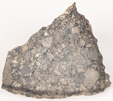 |
Vesta NWA 6694 Polymict Eucrite Meteorite Slice. There are only three planetary bodies that we cam match up with actual meteorites, Mars, the Moon and the second largest asteroid Vesta with a diameter of over 326 miles. Unlike all of the other meteorites, the stony meteorites from these three bodies are not magnetic. All of the Vesta meteorites come from a gigantic impact crater at its South Pole that is so deep that it exposes the asteroid's interior. This large section of NWA 6694 found in Morocco in 2009 is 3¼ x 2½ inches, weighing a hefty 38.5 grams. This stony meteorite is known as an achondrite Polymict Eucrite. Achondrite means that there are no visible chondrules because of high temperatures in the formation of this large asteroid. This Polymict Eucrite is a breccia of several different types of rocks having large angular clasts of white, gray and black composed of very fine grain material. Only a single meteorite weighing just over 5 Kg was found. Presented in a 5½ x 4½ inch Riker mount. Estimate Value $500 - UP
View details and enlarged photo
| Realized
$313 |
Lot 882 |
 |
Meteorite Brahin Pallasite 48.9 Grams. Pallasites are indeed "Gemstones" from space as they are a rare type of iron-nickel meteorite that have beautiful olivine crystals interspersed in the iron-nickel matrix. The first Brahin Pallasite meteorite was discovered in 1810 by farmers in the Minsk, Belorussia region of Russia. In the 200 years since then only eleven meteorites have been found from this fall totaling about 1000 kg. This 48.9 gram 2x2 inch polished specimen displays many olivine crystals evenly interspersed throughout the iron-nickel matrix. Even though the section is thick, there is some translucence of the olivine crystals when held up to a light source. Housed in a 6x5 inch Riker Mount. Estimate Value $350 - UP
View details and enlarged photo
| Realized
$204 |
Lot 883 |
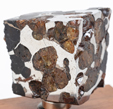 |
American Brenahm Pallasite Meteorite. The Brenham pallasite fell to earth some 1,000-2,000 years ago in Kiowa County near Haviland, Kansas. It is the most famous of all American pallasites and was perhaps the largest fall of a pallasite in recorded history with over 6 tons of recovered meteorites. Although the local Indians knew of this meteorite, it was not officially discovered until 1882 and designated a pallasite, which is a mixture of an iron-nickel matrix with crystals of olivine. This 1 x 1 x ¾ inch 44.9 gram section has been polished on four sides showing several green olivine crystals in the iron-nickel matrix with the remaining side still showing its original surface with regmaglypts. This three dimensional specimen is presented on a custom magnetic stand. Estimate Value $350 - UP
View details and enlarged photo
| Unsold |
Lot 884 |
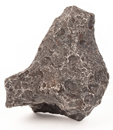 |
Esthetic Campo Del Cielo 3 Pounds. First recorded by the Spanish in 1576, the huge fall of Campo del Cielo (Valley of the Sky) iron-nickel meteorites occurred thousands of years ago. This 4 x 3 ¼ x 2 inch 3 pound Campo del Cielo iron-nickel meteorite has an esthetic cone shape with its iron-nickel surface covered with desirable regmaglypts (thumbprints) that formed when the meteor passed through Earth's atmosphere and the troilite in the meteorite melted. In addition to its beautiful esthetic shape, this esthetic complete meteorite has an interesting central peak. This is a perfect example of a palm sized Iron-Nickel meteorite. Estimate Value $300 - UP
View details and enlarged photo
| Realized
$225 |
Lot 885 |
 |
Set of Four Major Shapes of Indochinite Tektites. Tektites are glass-like objects that formed when a very large meteorite impacted the earth vaporizing itself and melting earth rocks to over 2000 degrees. The black Indochinites are found mostly in and around Thailand and are a glossy black color made up of mostly amorphous silica somewhat resembling obsidian. They have been dated to be about 800,000 years old which would be the date of the meteorite impact.when they formed out of the molten earth and meteorite. The tektites get their shape depending on the speed of rotation of the molten rock as it quickly cools after being ejected high into the earth's atmosphere. As the molten rock solidifies into small objects, if there is no rotation it will form a sphere, a slow rotation will form a flattened disc, fast rotation will form a rod or dumbell shape and a very fast rotation will form a teardrop shape. This lot contains four sizeable specimens of each of the four shapes. 1. a 2x2 inch sphere weighing 109grams. 2. a 3x2.5 inch flattened disc weighing 138 grams. 3. a 4x1.25 inch dumbbell weighing 121 grams and 4. a 3x1 inch teardrop weighing 52 grams. Contained in a 8x6 inch Ryker Mount. Estimate Value $250 - UP
View details and enlarged photo
| Unsold |
Lot 886 |
 |
Allende Carbonaceous Chondrite Section With Oldest Inclusions in the Solar System. This important Carbonaceous V3 Allende meteorite section is from one of the most famous and studied meteorites. The section weighs 4.94 grams and is 1½x¾ inches of the rare and important Carbonaceous Chondrites which make up only 4% of all meteorite falls. What makes these Carbonaceous meteorites special is that they are the most primitive of all meteorites and contain Calcium-aluminum rich inclusions which were the very first material formed when the nebular disk started to cool down and estimated to be 4.567 billion years old. This material is 30 million years older than the earth and 287 million years older than the oldest rocks found on earth. The Cai's are irregular shaped white inclusions in the black Carbonaceous matrix which also contains lighter colored chondrules. Estimate Value $250 - UP
View details and enlarged photo
| Realized
$384 |
Lot 887 |
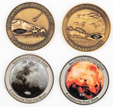 |
Collection of Four Meteorite Medals With Meteorite Fragments. Each of these limited edition meteorite medals contains a fragment of the meteorite being commemorated. This is a type set of meteorites containing a Martian, Lunar, stony and iron-nickel meteorite. Each medal is 48mm in diameter in either brass or copper nickel. The Martian meteorite NWA 2986 number 110 of 250 was discovered by Nomads in the Sahara Desert in2006. The Lunar meteorite a feldspecific breccia NWA 2995 was found by Nomads in the Sahara Desert in 2005 and this medal is numbered 207 out of 250. The stony meteorite NWA 869 medal #738 of 1000 was found by the Nomads in the Sahara Desert in 2000. The iron-nickel meteorite Camp del Cielo #437 out of 1000 was described by the Spanish explorers in Gran Chaco, Argentina in 1576. Estimate Value $225 - UP
View details and enlarged photo
| Unsold |
Lot 888 |
 |
Lucite Cube Containing Particles of a Martian Meteorite. The very first offering of any planetary rocks occurred in 1997 when meteorite dealer Daryl Pitt offered 1/10th of a carat of the rare Martian meteorite Zagami. The very first Zagami Martian Lucite cube sold for $1,434 in 1997. Zagami is a Basalt Martian Shergottite that was an observed fall, with meteorite specimens found near Zagami Rock, Katsina Province, Nigeria on October 3, 1962.
This historic 2.5 inch Lucite cube containing 1/10 carat of particles from the Martian meteorite Zagami comes with its original Mars Owner's Manuel which contains many details concerning meteorites in general and Martian meteorites in particular. We know the Zagami meteorite originated on the Planet Mars from its oxygen isotopes and even small pockets of Martian air which matched the 1976 Viking lander�s analysis. Estimate Value $200 - UP
View details and enlarged photo
| Realized
$125 |